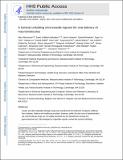A luminal unfolding microneedle injector for oral delivery of macromolecules
Author(s)
Abramson, Alex; Caffarel Salvador, Ester; Soares, Vance; Minahan Jr, Daniel J; Tian, Ryan Yu; Lu, Xiaoya; Dellal, David (David M.); Gao, Yuan; Kim, Soyoung; Wainer, Jacob P; Collins, Joy E; Tamang, Siddartha M; Hayward, Alison M; Yoshitake, Tadayuki; Lee, Hsiang-Chieh; Fujimoto, James G; Fels, Johannes; Frederiksen, Morten Revsgaard; Rahbek, Ulrik; Roxhed, Niclas; Langer, Robert S; Traverso, Carlo Giovanni; ... Show more Show less
DownloadAccepted version (916.7Kb)
Publisher Policy
Publisher Policy
Article is made available in accordance with the publisher's policy and may be subject to US copyright law. Please refer to the publisher's site for terms of use.
Terms of use
Metadata
Show full item recordAbstract
Insulin and other injectable biologic drugs have transformed the treatment of patients suffering from diabetes1,2, yet patients and healthcare providers often prefer to use and prescribe less effective orally dosed medications3–5. Compared with subcutaneously administered drugs, oral formulations create less patient discomfort4, show greater chemical stability at high temperatures6, and do not generate biohazardous needle waste7. An oral dosage form for biologic medications is ideal; however, macromolecule drugs are not readily absorbed into the bloodstream through the gastrointestinal tract8. We developed an ingestible capsule, termed the luminal unfolding microneedle injector, which allows for the oral delivery of biologic drugs by rapidly propelling dissolvable drug-loaded microneedles into intestinal tissue using a set of unfolding arms. During ex vivo human and in vivo swine studies, the device consistently delivered the microneedles to the tissue without causing complete thickness perforations. Using insulin as a model drug, we showed that, when actuated, the luminal unfolding microneedle injector provided a faster pharmacokinetic uptake profile and a systemic uptake >10% of that of a subcutaneous injection over a 4-h sampling period. With the ability to load a multitude of microneedle formulations, the device can serve as a platform to orally deliver therapeutic doses of macromolecule drugs.
Date issued
2019-10Department
Massachusetts Institute of Technology. Department of Chemistry; Massachusetts Institute of Technology. Institute for Medical Engineering & Science; Massachusetts Institute of Technology. Department of Mechanical Engineering; Massachusetts Institute of Technology. Division of Comparative Medicine; Massachusetts Institute of Technology. Media Laboratory; Massachusetts Institute of Technology. Research Laboratory of Electronics; Massachusetts Institute of Technology. Department of Electrical Engineering and Computer Science; Massachusetts Institute of Technology. Department of Biological Engineering; Koch Institute for Integrative Cancer Research at MITJournal
Nature Medicine
Publisher
Springer Science and Business Media LLC
Citation
Abramson, Alex et al. "A luminal unfolding microneedle injector for oral delivery of macromolecules." Nature Medicine 25, 10: 1512–1518 © 2019 The Author(s)
Version: Author's final manuscript
ISSN
1078-8956
1546-170X